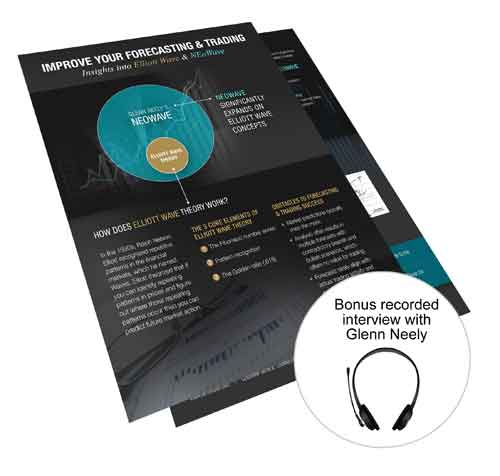NEoWave Blog
11/25/2019 - NEoWave Staff
Article #3 of 7: Glenn Neely's tips to correctly interpret Elliott Wave patterns
Introductory note: This is Part 3 of a 7-part series. In these articles, Glenn Neely, NEoWave founder and author of Mastering Elliott Wave, discusses Elliott Wave concepts from his unique point of view as a world-renowned Elliott Wave expert. In this frank, open, and insightful interview, Mr. Neely reveals his advanced forecasting and trading concepts – based on his decades of experience as the creator of NEoWave forecasting and his exciting Neely River Trading Technology, which fuels profitable trading results.
Unfortunately, a lot of people completely misunderstand the concept of Elliott Wave pattern analysis. They think it’s mostly the way something looks. However, this approach is actually orthodox Elliott Wave – the first 50 years of Elliott Wave – before my
Mastering Elliott Wave book was published in 1990. As you may know, R.N. Elliott started to analyze markets around the 1930s, but he didn’t write much about this until the 1940s. So it was about 50 years after Elliott released his ideas to the public that I released my book, which revolutionizes Wave theory with logic and scientific rules.
Orthodox Wave theory is flexible; it’s not necessarily logical. The foundation was weak and too easy to manipulate by the individual analyst. You could have 5 or 10 different people looking at a set of Elliott Wave patterns and charts, and each person could arrive at completely different forecasts. Of course, being the way I am, I didn’t like that at all.
So I worked for over two decades to fix this problem. I realized there were missing concepts that could help solidify patterns, and rules that help to identify patterns. I saw that behavior characteristics and traits were missing from orthodox Wave theory, even including critical points such as how to draw your charts and what kind of data to use to make your charts – a host of important topics that I addressed in my book.
In my book, Chapter 5 presents nearly all the information ever previously released on Elliott Wave. The first four chapters discuss the preliminary process, before you get to the actual analysis. In Chapters 6 through 12, I offer many concluding concepts. For example:
- How do you finish patterns?
- How do you confirm patterns?
- How do you get the complex patterns?
- How do you identify relationships and other components that help to reinforce your Wave analysis?
Traditional, orthodox Elliott Wave theory was mostly just – at least from many people’s perspective –simply pattern recognition. For example, you might see something that looks like a contracting triangle. So you have contracting trend lines in it, with price action that’s congesting from a more violent period to a deader and deader period. You might read a lot into this particular contracting triangle but, in reality, that’s not the way Wave theory actually works.
Wave theory is a rule-based theory, and (most of the time, when it obeys the rules) it will have a particular look. But consider this: Even if it obeys the rules and has a pattern that doesn’t look anything like a contracting triangle, it still could be a contracting triangle! Or you can have something that’s a certain kind of correction, perhaps an ABC that may or may not look like the Elliott Wave patterns and diagrams in the traditional books on Elliott Wave. In fact, you can have five-Wave moves that will look very different from those shown in traditional books on Elliott Wave.
Therefore, keep this in mind: Elliott Wave is a rule-based theory, and the rules are more important than the way it looks. Being able to correctly interpret Elliott Wave patterns is one of the primary differences between NEoWave and Elliott Wave.
NEoWave requires hardcore rule adherence, and there are quite a number of rules regarding how things should behave, what they should do, and how they should relate – but not necessarily how they look. Correctly interpreting Elliott Wave patterns is a big dividing point between traditional, orthodox Elliott Wave and NEoWave.
Read the articles in this 7-part series:
Article #1,
Article #2,
Article #3,
Article #4,
Article #5,
Article #6,
Article #7
Get 2 educational tools FREE!
Get Real-World Advice for Better Forecasts and Trades for FREE! Sign Up Now!
Learn more about:
NEoWave Trading Service
NEoWave Forecasting Service
Mastering Elliott Wave by Glenn Neely
Follow us @NEoWaveTheory:
Twitter: https://twitter.com/NEoWaveTheory
Facebook: https://www.facebook.com/NEoWaveTheory


